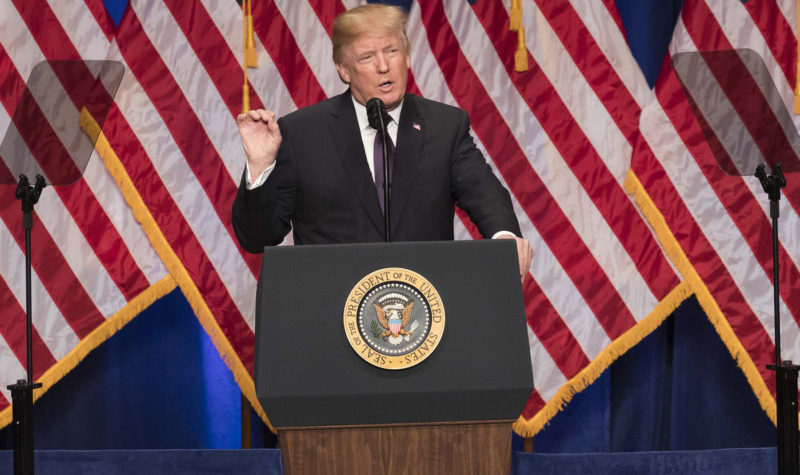Trump’s National Security Strategy mentions the Arctic, but not climate change

Last week, the Trump Administration released its National Security Strategy, a 55-page document intended to lay out the administration’s strategic interests, threats, and capabilities.
Since the 1980’s, U.S. administrations have typically released such a strategy about once per four-year term. In releasing its NSS in December, the Trump Administration became the first to do so in its first year in office.
Like the two NSSs previously released by the Obama administration, Trump’s NSS does in fact identify the United States’ strategic interests in the Arctic. In doing so, Trump became just the second U.S. president to include the Arctic in his NSS. However, President Trump’s NSS approaches the Arctic in a decidedly different manner than the Obama administration.
The Arctic Under Obama
The Obama administration’s inaugural NSS, released in May 2010, was the first ever to name the Arctic as an emerging region in which the U.S. had strategic interests. Under a section titled “Sustain Broad Cooperation on Key Global Challenges,” the 2010 NSS read:
“Arctic Interests: The United States is an Arctic Nation with broad and fundamental interests in the Arctic region, where we seek to meet our national security needs, protect the environment, responsibly manage resources, account for indigenous communities, support scientific research, and strengthen international cooperation on a wide range of issues.”
That broad expression of U.S. interests in the Arctic was further refined in Obama’s second and final NSS, published in February 2015, in which the administration reiterated that the Arctic had strategic value to the US. In reference to maritime security and cooperation, the 2015 NSS stated:
“…we seek to build on the unprecedented international cooperation of the last few years, especially in the Arctic as well as in combating piracy off the Horn of Africa and drug smuggling in the Caribbean Sea…”.
In reference to energy security, the 2015 NSS included the statement, “We will also stay engaged with global suppliers and our partners to reduce the potential for energy-related conflict in places like the Arctic and Asia.”
Finally, the 2015 NSS reiterated the impact of climate change in the Arctic and its impacts on Alaska communities.
The Arctic in Trump’s NSS
While the Trump NSS continues the Obama-era tradition of citing the Arctic, it does so in a decidedly different manner. Rather than identifying the United States’ interests in the Arctic and potential threats it faces in the region, the Trump Administration cites the Arctic as a sphere where the U.S. must demand better outcomes from international organizations, like the Arctic Council. The Arctic is cited by name once in Trump’s NSS, under a section titled “Achieve Better Outcomes in Multilateral Forums.” The document states:
“The United States must lead and engage in the multinational arrangements that shape many of the rules that affect U.S. interests and values. A competition for influence exists in these institutions…A range of international institutions establishes the rules for how states, businesses, and individuals interact with each other, across land and sea, the Arctic, outer space, and the digital realm.”
The document goes on to state that while these “multilateral arrangements” are important for maintaining rules and keeping common domains like the Arctic free and open, the Trump Administration will not allow these forums—like the Arctic Council—that govern such rules to impinge upon U.S. sovereignty.
The Trump Administration has made it clear that it is not satisfied with the outcomes of international bodies it engages with, such as NATO or the United Nations. While the NSS does not cite the Arctic Council by name, there are few other “multilateral arrangements” that shape the rules in the Arctic.
The Trump Administration has been largely quiet regarding the Arctic Council since the May 2017 Arctic Council summit in Fairbanks, Alaska when administration officials sought to alter the wording of the final resolution in order to soften its stance on climate change. Whether the NSS signals a shift in U.S. policy at the Arctic Council level remains to be seen.
Climate Change and ‘Energy Dominance’
Without specifically naming the Arctic, two other sections of the Trump NSS touch upon Arctic issues. First, and most notably, the Trump NSS does not include any mention of climate change as a national security threat, something that the two Obama-era NSSs and Trump’s own Secretary of Defense James Mattis have stated.
Second, the new NSS stresses the Trump policy of “Energy Dominance,” a more muscular version of “energy independence” that depends upon increasing domestic energy production. Although not stated in the NSS, the Energy Dominance policy likely includes increasing Alaska oil and gas production through efforts like tapping into ANWR.